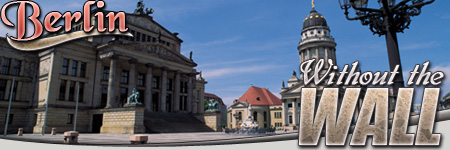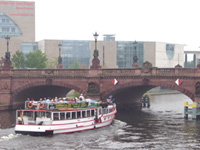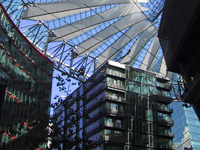|

Explore the New, Modernized Berlin, Germany
by Susan McKee
Spy
novels and movies set in the Cold War era don't prepare
you for the Berlin of today. The film noir atmosphere
with its dark streets, seedy apartments and furtive
characters has vanished in a flurry of redevelopment.
 |
I've visited Berlin several times in the 15 years
since the fall of Communism, and each time I'm disoriented
as old landmarks are transformed. The Berlin Wall?
Obliterated. Checkpoint Charlie? A tourist site.
Where once there was the no-man's-land of mines and
barbed wire near the deserted Potsdam train station
in East Berlin, there's now a 21st century complex
of restaurants, shops and offices anchored by Sony's
German headquarters.
The formerly trendy West Berlin shopping area along
Kurfürstendamm is showing its age. Apartment
rents are falling in that part of town. There's even
the occasional vacant storefront, because the city's
energy has moved east.
Unter den Linden, the stylish tree-lined boulevard
once isolated on the east side of the wall, has been
restored to its prominence as not only the best address
for foreign ambassadors, but as an upscale boutique
shopping district.
Tall construction cranes dot the landscape, helping
to erect not only civic buildings - such as the new
five-level railroad station - but the new American
embassy, hotels, office blocks and shopping complexes.
Name-brand architects from I.M. Pei to Frank Gehry
are transforming the skyline.
Part of what makes the new Berlin so vibrant is the
calculated strategy of multiple downtowns. Instead
of one focus for commerce, there are at least five
business nodes planned with mixed retail, office and
residential development (Potsdamer Platz being merely
the latest). Street life continues into the wee hours
in most of the city.
And the museums - wow! I've always loved the Pergamon
with its collection of ancient treasures brought to
Germany from Greece, but it's just one of five being
renovated on Museum Island behind the recently restored
Berlin cathedral with its magnificent organ.
They tell me there are 170 museums in Berlin, and
I figure it'll take me a lifetime to see them all.
One of the newest is the Film Museum in Potsdamer
Platz, covering more than a century of cinema from
silent movies to contemporary offerings. Four more
museums open this year: the restored Max-Liebermann-Villa
am Wannsee, the permanent exhibition by the Germany
Historical Museum in the baroque Zeughaus, the Fernsehmuseum
Berlin (museum for television) and the Bode Museum
on Museum Island.
Sightseeing boats once again ply the River Spree,
with guides pointing out places along the shore where
escapees from the east either made it to freedom or
perished in the attempt.
 |
Most American visitors arrive in Berlin by airplane
(there are lots of connections both from abroad and
within Europe). Be sure to get a Berlin Welcome Card
- public transportation is easy and the best way to
get around. A card (good for either 48 or 72 hours
of travel) lets you ride both the buses and the subway
as well as garner discounts of up to 50% on admission
to museums and city tours.
Be sure to see the Brandenburg Gate - once cordoned
off as part of the Berlin Wall, it's been restored
as a magnificent portal. The last time I was there,
only pedestrians were allowed to go through its arches
(it seems the rumble of buses and cars was shaking
loose the massive stones!).
The Reichstag, the seat of the German Bundestag, has
been turned into a symbol of the reunited Germany.
Built in the late 19th century and severely damaged
in the 1930s, it was turned into a museum in the Cold
War era. Now it sports a clear glass dome, giving
a new meaning to "transparent government".
There's fine dining galore in Berlin, but don't miss
the street food. The city's large Turkish population
gravitates to small shops called Döner Kebab
serving the absolutely best gyros you've ever tasted.
Curry wurst is an acquired taste, although you'll
see people at every corner Imbiss (or snack hut) munching
away on the Indo-German specialty.
Perhaps the best way to see Berlin is behind the wheel
of a Trabant. These rattletrap cars, manufactured
between 1958 and 1991, are an unlikely souvenir of
Communist rule.
They were the only auto ordinary East
Germans could buy during the days of the German Democratic
Republic, so they represented freedom in an otherwise
autocratic state.
Trabis weren't cheap - 30,000 Deutsch Marks (an average
annual salary) - and people waited for delivery an
average of 12 years after ordering. Materials shortages
behind the Iron Curtain resulted in a car made of
Duroplast - a combination of cotton and phenolharz,
a kind of plastic.
With a two-stroke, two-cylinder engine and 26 horsepower,
Trabis are fueled like lawnmowers: one liter of oil
for every 50 liters of gasoline. There's no gas gauge,
only a dipstick to check the level of petrol.
Hardly anyone drives one these days - except for nostalgia
buffs and tourists. Yes - you can drive around East
Berlin behind the wheel of a Trabant, courtesy of
Trabi-Safari-Tours! There are more than a dozen Trabis
in the company garage, so you have your choice of
style and color. There's even the Stretchtrabi, a
combination convertible and limousine.
How could I resist? I signed up to drive a jaunty
powder blue model - and what a trip it was. Starting
off at the Gendarmenmarkt, I clutched the wheel for
about 45 minutes of start-and-stop driving through
the streets of East Berlin.
A second brave driver took over at the halfway point
when we stopped at the East Side Gallery - the longest
surviving stretch of the old Berlin Wall. Its original
graffiti art (including the infamous Brezhnev kiss)
is peeling now, as the memory of the bad old days
of Communist rule fades.
Once I was the passenger instead of the driver I could
enjoy the ride. People waved at us as we drove along,
finishing up alongside Checkpoint Charlie.
After my ride, I stopped into a souvenir shop.
An American tourist was debating with his wife whether
to buy a yellow or a blue model of a Trabant. I pointed
out the window at "my" Trabi and asked him,
"Why settle for a toy when you can drive the
real thing?"
|